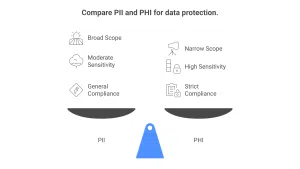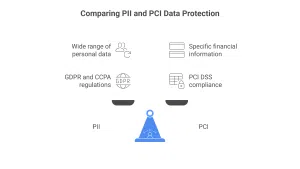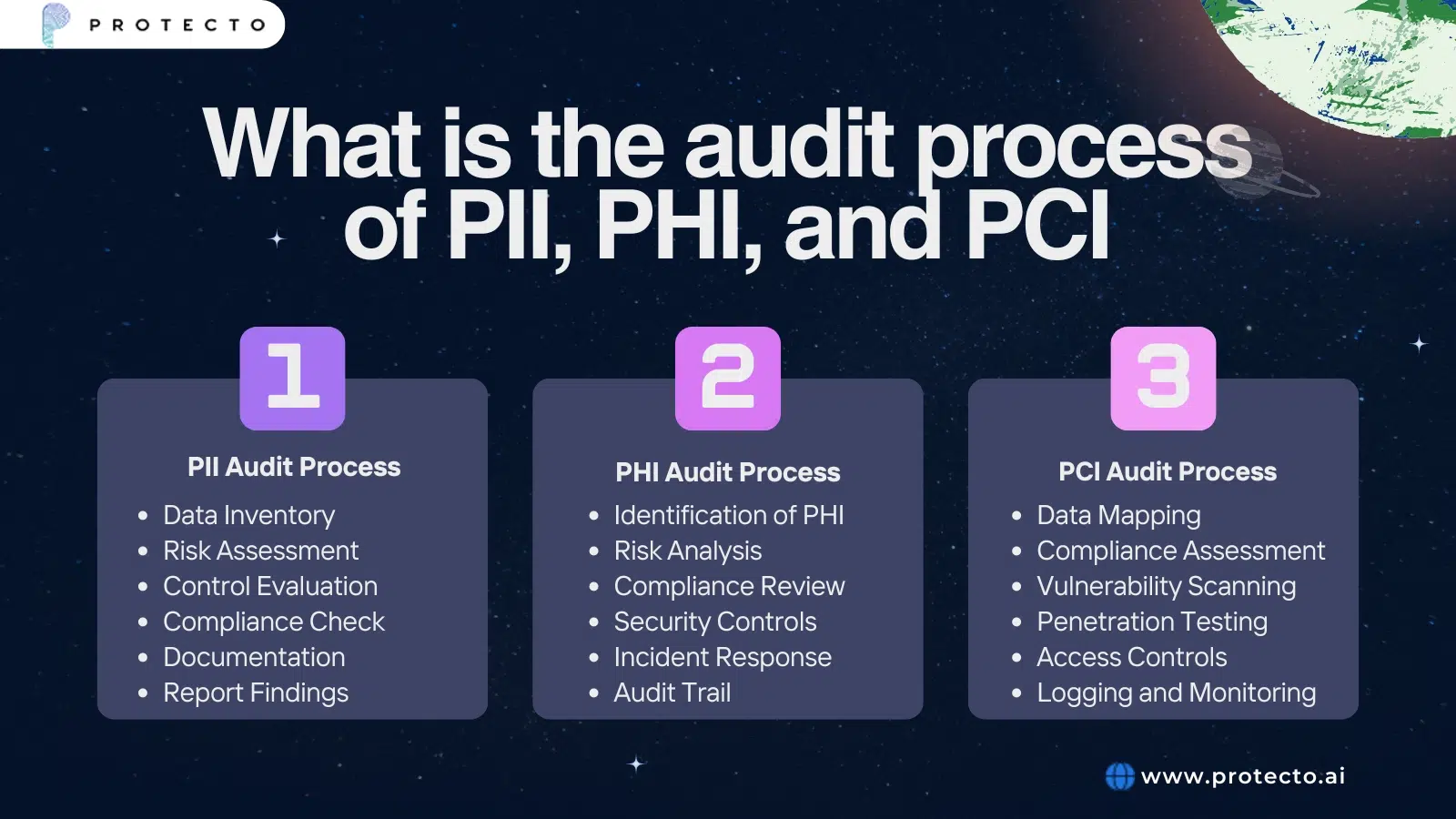In this age of digital supremacy, keeping our data safe and respecting privacy are super important. As more and more people and businesses use online platforms, it’s crucial to understand what types of data need that extra layer of protection, especially when it comes to PII vs PHI vs PCI.
Understanding the distinctions between PII (Personally Identifiable Information), PHI (Protected Health Information), and PCI (Payment Card Information) is crucial. Each data type carries its own risks and responsibilities, and being aware of them empowers us to protect our information effectively.
So, what exactly is PII? It’s any info that can identify someone, like your name, address, or social security number. Then there’s PHI, which is all about health-related info that has to be handled with care, thanks to regulations like HIPAA. And don’t forget about PCI, which covers your credit card info and has pretty strict security standards, known as PCI DSS.
The stakes are high in managing PII, PHI, and PCI. Mishandling these data types can lead to severe consequences such as hefty fines, legal troubles, and damage to reputation. This underscores the urgency of proper data management and the need for strict compliance with regulations.
What is PII (Personally Identifiable Information)?
Definition of PII
PII refers to any data that can identify an individual. This includes obvious identifiers like full names, postal addresses, social security numbers, and email addresses. It also encompasses less direct information, such as IP addresses and login credentials, that can link back to a specific person.
Examples of PII
Examples of PII include a wide range of data points: full names, passport numbers, driver’s license numbers, and even biometrics like fingerprints. Credit card numbers and other financial details are also considered PII when they can tie back to an individual. This covers an entire gamut of user data that can vary in degree of sensitivity. Therefore, different types of PII have different requirements in terms of protection and compliance.
PII now also covers digital identifiers like IP addresses, login IDs, digital images, and other unique identifiers. Even pieces of information that might not identify a person on their own, such as a birth date or zip code, can be classified as PII when combined with other data to identify an individual.
Examples of PII include:
- Full Name
- Social Security Number
- Address
- Driver’s License or Passport Number
- Mother’s Maiden Name + Place of birth = could result in Full Name + Date of Birth within public records
The importance of PII in data protection cannot be overstated. Organizations must safeguard PII to protect individuals from identity theft, fraud, and unauthorized access to sensitive information. Strong data protection measures also maintain customer trust and comply with legal standards.
PII Compliance
Various regulatory frameworks govern PII Compliance. The GDPR in Europe and the CCPA in California are two prominent examples. These laws mandate that organizations follow strict guidelines for collecting, storing, and processing PII.
Best practices include data encryption, access controls, and regular audits to ensure compliance and minimize risks.
What is PHI (Protected Health Information)?
Definition of PHI
Protected Health Information (PHI) refers to any details about a person’s health, healthcare, or payment for healthcare that can be linked to a specific individual. This includes information such as medical records, test results, insurance details, and billing statements. Essentially, PHI encompasses all the data shared and used by doctors, insurers, and patients that pertains to an individual’s health.
Examples of PHI
PHI covers a wide range of information, including a patient’s diagnosis, prescription history, medical records, treatment plans, laboratory test results, insurance details, and billing information. Sensitive personal details like names, birthdates, addresses, and Social Security numbers are also considered PHI when they can be linked back to someone’s health information.
The 18 PHI identifiers are:
- Patient name
- Address (all components)
- All dates (birthdate, treatment dates, etc.)
- Telephone numbers
- Vehicle ID and serial numbers
- Fax numbers
- Device identifiers & serial numbers
- Most device IDs are derived from the MAC address, IMEI number, or ESN number.
- Email addresses
- URLs
- Social security numbers
- IP addresses
- Medical record numbers
- Biometric IDs
- Health plan numbers
- Full-face photos
- Account numbers
- Any other uniquely identifying ID or code
- Certificate or license numbers
PHI is pivotal in the healthcare industry, as safeguarding this information is crucial for fostering trust between patients and their healthcare providers. This trust is a cornerstone of quality care. Protecting PHI ensures that patients’ personal and sensitive health information remains confidential, which is essential for maintaining patient trust and the overall integrity of the healthcare system.
PHI Compliance
Regulations and Standards (e.g., HIPAA)
PHI is subject to strict regulations, with the Health Insurance Portability and Accountability Act (HIPAA) being the most prominent. HIPAA sets the standards for protecting PHI, and healthcare organizations must adhere to these guidelines to ensure the safety and confidentiality of patient information.
Compliance Requirements and Best Practices
To comply with PHI regulations, healthcare organizations must implement various measures, such as encryption, access restrictions, and regular audits. These practices are essential for maintaining PHI security and avoiding serious consequences, including hefty fines and legal issues. Understanding and protecting PHI is not just a legal obligation but also a critical aspect of maintaining patient trust and ensuring the delivery of high-quality care.
What is PCI (Payment Card Information)?
Definition of PCI
Payment Card Information (PCI) refers to the critical data related to your payment cards used during shopping, such as your name, card numbers, expiration dates, and security codes. This information is essential for processing payments but also makes it a prime target for cybercriminals if not handled properly.
Examples of PCI
Examples of Payment Card Information include:
- Cardholder Name: The name printed on the card.
- Card Number: The unique 16-digit number on the front of the card.
- Expiration Date: The date the card expires.
- Security Code: The CVV or CVC number on the back of the card.
Importance of PCI in Financial Transactions and Security
Protecting Payment Card Information is crucial because if it falls into the wrong hands, it can lead to fraud or identity theft. Businesses dealing with PCI must adhere to strict security practices to safeguard this data. Ensuring the security of PCI not only protects customers but also helps maintain trust and prevent potential financial losses and reputational damage.
PCI Compliance
To protect payment information, companies must comply with the Payment Card Industry Data Security Standard (PCI DSS). These regulations provide guidelines on securely handling payment data, including encryption, access controls, and regular monitoring. Compliance with PCI DSS is mandatory for businesses dealing with PCI.
Non-compliance can result in significant fines, financial losses, and damage to a company’s reputation. Best practices for maintaining PCI compliance include encrypting cardholder data, limiting access to sensitive information, regularly reviewing security measures, training employees on PCI standards, and conducting frequent risk assessments. Following these practices helps organizations protect PCI data and build customer trust.
What Are the Key Differences Between PII vs PHI?
Let’s break down the difference between PII (Personally Identifiable Information) and PHI (Protected Health Information) in a way that’s easy to grasp.
PII refers to any information that can identify you as an individual, such as your name, social security number, or home address. It’s a pretty broad category that pops up in all sorts of industries, and the main reason we protect PII is to keep people’s identities safe and prevent things like identity theft.
On the flip side, PHI is a specific type of PII that’s all about health information. This includes medical records, insurance info, and anything related to your health status or treatment. PHI is taken seriously, especially in the U.S., because it’s governed by laws like HIPAA (the Health Insurance Portability and Accountability Act). These laws make sure that healthcare providers, insurers, and others handling this information follow strict rules to keep it safe.
So, the key takeaway? PII is a wide-ranging category of personal data, while PHI zooms in on health-related information. Because PHI is so sensitive, it comes with more rigorous compliance standards than PII. Organizations need to understand these differences to implement the proper security measures and stay in line with all the necessary regulations.
What are the key differences between PII vs PCI?
When it comes to the difference between PII and PCI, these are terms you might encounter when discussing data protection.
PII, or Personally Identifiable Information, is information that can be used to identify someone. Think of names, addresses, social security numbers, and even email addresses. This kind of information is essential in many industries, like healthcare, finance, and tech, where knowing who someone is can really matter.
Now, PCI stands for Payment Card Information and is a bit more specialized. It refers specifically to details about your payment cards, such as credit and debit card numbers, cardholder names, expiration dates, and those little CVV codes on the back. This data is super sensitive because it’s directly tied to your money and transactions, so keeping it safe is crucial to prevent fraud.
Regarding regulations, PII is protected by various laws like GDPR and CCPA, which lay down some strict rules for handling this information. Conversely, PCI compliance is governed by the PCI DSS, which has specific guidelines that organizations must follow when dealing with payment card info.
In a nutshell, PII covers a wide range of personal data, while PCI is all about financial information. Both need to be handled carefully and follow strict regulations, but they focus on different aspects of data protection.
Why is it essential to protect PII, PHI & PCI, and keep them secure?
Keeping personal information safe is vital for both businesses and individuals. Each type of data—like PII, PHI, and PCI—comes with its own set of risks and significance.
Let’s break it down a bit. PII, or Personally Identifiable Information, covers things like your name, address, and Social Security number. If this info gets into the wrong hands, it can lead to identity theft and fraud. When someone’s PII is compromised, it can mean financial losses, legal trouble, and a hit to their reputation. No one wants that!
PHI stands for Protected Health Information, which is even more sensitive. It’s all about your health records, prescriptions, and insurance details. If someone accesses your PHI without permission, it can lead to misuse of your medical information, which could even affect your healthcare. Plus, when PHI is breached, it breaks our trust in our healthcare providers, and that’s a big deal.
Then there’s PCI, which refers to Payment Card Information, like credit card digits and security codes. If there’s a breach here, it can lead to severe financial losses—for both individuals and businesses. Companies dealing with PCI need to have strong security to keep this data safe. Otherwise, they risk losing money, facing lawsuits, and damaging their reputation.
Why do organizations need to protect PII, PHI, and PCI data?
If organizations don’t take the necessary steps to protect PII, PHI, and PCI, they could be in for a rough ride. Regulatory bodies can slap hefty fines on them for not following data protection rules. Compliance is key here—think HIPAA for PHI and PCI DSS for PCI. Ignoring these regulations can lead to financial penalties and even legal issues that could really hurt a business.
Let’s not forget that a data breach is a surefire way to lose customer trust. Once that trust is gone, it can be challenging to win it back, leading to lost business and long-term damage to a company’s reputation. So, it’s more than just avoiding fines; it’s about keeping that trust and ensuring everyone’s data is safe.
In short, securing PII, PHI, and PCI isn’t just a checkbox on a to-do list. It’s crucial for protecting people’s privacy, maintaining trust, and avoiding legal or financial headaches.
Protection Requirements and Strategies
PII Protection
Whether running a business or just trying to keep your data safe, understanding how to guard Personally Identifiable Information (PII) is vital. PII is any info that can identify someone—think names, addresses, Social Security numbers, and other confidential attributes.
Enterprises need to step up their security game to achieve strong and foolproof PII compliance. Strong encryption helps ensure that data is secure, whether sent somewhere or sitting on a server. It’s also essential to control who gets access to this information. Only the right people can see sensitive data by setting up role-based permissions.
Regular audits and monitoring can also help catch unauthorized access before it becomes a more significant issue. And let’s not forget about training! Familiarizing employees with the essence of data protection can make a difference since human error is often a big part of security breaches.
One smart move for protecting PII is to have a solid compliance program in place. This means following regulations like GDPR or CCPA, depending on your location. Keeping privacy policies up to date and being transparent about how data is collected helps, too. And when it comes to sharing PII with third parties, having firm contracts that outline how to protect this info is a must.
PHI Protection
Now, let’s talk about Protected Health Information (PHI). This type of information is really sensitive—think medical records and health insurance details—so it needs extra care. The Health Insurance Portability and Accountability Act (HIPAA) lays down the law on how to protect it. Organizations should use encryption, access controls, and audit logs to stay compliant. Only authorized folks can access PHI; everything is logged for security.
But it’s not just about tech—administrative measures are also super necessary. Regular risk assessments can help spot vulnerabilities in how PHI is handled. Training employees on HIPAA rules and the importance of safeguarding health information is crucial. And having a plan for when things go wrong—like notifying people if there’s a breach—is equally important.
Let’s not overlook physical safeguards! This could mean locking up paper records or ensuring that devices storing PHI are secure. Regularly checking and updating these protections helps keep everything secure.
PCI Protection
Finally, we mustn’t forget to protect Payment Card Information (PCI). A set of standards called the Payment Card Industry Data Security Standard (PCI DSS) outlines how to keep this data safe. Organizations must comply with 12 main requirements that focus on protecting cardholder data, securing networks, and implementing strong access controls. For example, encrypting cardholder data during transmission and storage is a must, and having a good firewall is essential to fend off outside threats.
Another biggie is regularly monitoring and testing networks. This means running vulnerability scans and penetration tests to spot security weaknesses. It’s also essential to have a solid information security policy that guides how PCI data is handled.
Access to PCI data should be limited to only those who really need it—this ensures that only employees with a valid reason can access this information. Implementing strong password policies and using multi-factor authentication adds an extra layer of protection. Training and awareness programs help everyone understand the implications of PCI compliance and their role in protecting payment card information.
And don’t forget about being prepared for potential security issues! It’s wise to have an incident response plan in place. This plan should clearly outline what to do if there’s a data breach, like notifying those affected and working with payment networks to minimize the impact.
Following these strategies for protecting PII, PHI, and PCI can significantly lower the risk of data breaches. These measures help secure sensitive information and build trust with customers and stakeholders, showing that organizations are serious about data security.
What is the audit process of PII, PHI, and PCI
Auditing PII, PHI, and PCI is essential for maintaining compliance and ensuring data security. Each data type has a unique set of audit steps based on its needs.
PII Audit Process
Here’s a quick rundown of the audit process for PII:
- Data Inventory: First things first, you need to figure out what counts as PII. That means checking every data source to ensure nothing slips through the cracks.
- Risk Assessment: Next, consider the risks of storing and using PII. Consider who can access it and what could happen if there’s a data breach.
- Control Evaluation: Review the security measures you have in place to protect that PII. Are you using encryption, access controls, and data masking? The goal is to keep that info safe from prying eyes.
- Compliance Check: Make sure everything aligns with regulations like GDPR and CCPA. This might mean checking agreements and making sure people have given their consent.
- Documentation: Keeping good records is critical. You’ll want to document all your PII processing activities, consent forms, and any incidents that pop up. Auditors will want to see that everything is current and complete.
- Report Findings: Finally, summarize everything in an audit report. This should outline any issues and suggest ways to improve.
PHI Audit Process
Protected Health Information (PHI) refers to health info that can identify someone, and the audit process here is pretty strict because it’s sensitive data.
- Identification of PHI: Just like with PII, start by figuring out what counts as PHI. This includes patient records, insurance info, and any health-related data.
- Risk Analysis: Next, you’ll want to conduct a risk analysis to spot any potential threats to PHI. Check physical security and access controls and look for vulnerabilities in electronic health records.
- Compliance Review: Auditors will check if you’re following HIPAA regulations. This means reviewing how you handle PHI, including storage, access, and sharing practices.
- Security Controls: Evaluate how your security measures are working, like encryption and firewalls. Make sure that only authorized folks have access to PHI.
- Incident Response: Look over your procedures for dealing with data breaches involving PHI. You want to ensure you can detect, report, and handle any breaches effectively.
- Audit Trail: Ensure a clear audit trail for all transactions involving PHI. This means logging every access, change, and transmission so you can trace everything back.
PCI Audit Process
PCI compliance is governed by the PCI DSS (Payment Card Industry Data Security Standard), and the audit steps are thorough.
- Data Mapping: Start by mapping all systems that store, process, or transmit PCI data. Identify databases, servers, and network components that handle payment info.
- Compliance Assessment: Next, check how well you meet PCI DSS requirements. This involves looking at your security policies and how your network is set up.
- Vulnerability Scanning: Regular vulnerability scans are required for PCI audits. These help you spot any security weaknesses in your systems.
- Penetration Testing: In addition to scans, penetration testing simulates attacks on your systems to identify and remediate vulnerabilities before they are exploited.
- Access Controls: Review your controls to ensure only authorized personnel can access payment card data.
- Logging and Monitoring: Ensure you have logging and monitoring systems set up to track access to PCI data. Regularly reviewing logs helps you catch any unauthorized access.
- Reporting: Finally, put together a detailed report of the audit findings. Highlight any non-compliance areas and recommend becoming fully compliant with PCI DSS.
What happens if an organization fails to protect PII / PHI / PCI?
Not protecting PII, PHI, or PCI can lead to some serious consequences, like:
- Legal Penalties: If you don’t comply with regulations like GDPR, HIPAA, or PCI DSS, you could face hefty fines. For instance, HIPAA violations can cost between $100 and $50,000 per incident.
- Reputation Damage: Data breaches can really hurt your organization’s reputation. When customers lose trust, it can lead to lost business and long-term brand damage.
- Financial Loss: In addition to fines, you might face lawsuits, compensation claims, and the costs of a breach and recovery.
- Operational Disruption: A data breach can disrupt operations, especially if it involves critical PII, PHI, or PCI. Organizations may need to halt operations to fix the issue, which can lead to lost revenue.
Auditing PII, PHI, and PCI is important for staying compliant and keeping your data safe. If you don’t secure these types of data, you could face notable legal, monetary, and reputational risks. Organizations need to keep up with regular audits to ensure they’re meeting the necessary standards and protecting sensitive information.
How Protecto Can Help You Protect PII, PHI, and PCI?
Organizations concerned with protecting PII, PHI, and PCI can consider using a service like Protecto. It’s a really handy platform that helps keep sensitive information, such as personal information, health records, and payment details, safe. It automates much of the data privacy and security work, so you can rest easy knowing you’re following essential regulations like HIPAA and PCI DSS.
Thanks to intelligent AI technology, Protecto can spot and categorize sensitive data, which helps lower the chances of a data breach. Plus, they offer continuous monitoring and real-time alerts, so you’re always in the loop and can act quickly if anything arises.
Conclusion
For businesses that deal with a lot of sensitive data, Protecto has strong encryption and tokenization tools that give you an extra layer of security. This helps you meet compliance requirements and builds trust with your customers by keeping their information safe and sound. It’s a solid choice for anyone looking to protect their data!
With this information, businesses can understand the critical nuances of these data types and implement the right measures to handle and process them safely.







